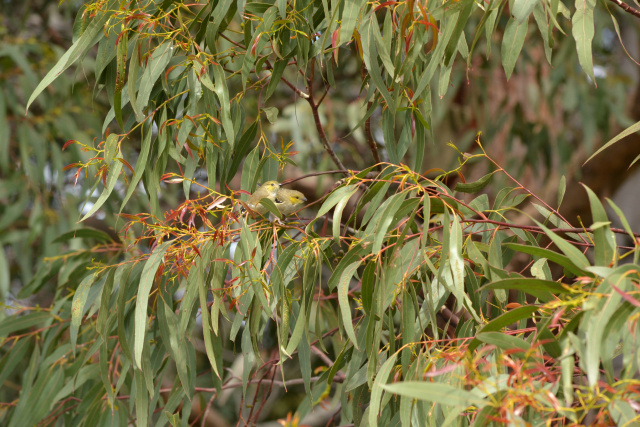Forty-spotted Pardalote
An estimated less than one thousand Forty-spotted Pardalotes continue to exist on planet Earth. They are confined to a few important corners of Tasmania - Flinders Island, Maria Island, Tinderbox and Bruny Island.
A remarkable bird with a very specialised life cycle and habitat, Forty-spotted Pardalotes have specialised needs in terms of their food and habitat.
Remnant 'White gum' (Eucalyptus viminalis) forest is critically important for the 'Forty-spots' future, and a landmark conservation program on Bruny Island, led by the Bruny Island Environment Network and Inala, is giving this bird a fighting chance at survival.

Forty-spotted Pardalote
"Forty-Spots"
Pardalotus quadragintus
Pardolotes; Pardalotidae
This small beautiful bird has an olive-green shoulder and back, with dark wings with about 20 white spots on each side, hence the name.
The birds chest and underside is a pale yellow colour. The bill is black and short.
90-120mm

A tiny bird with a short dark beak, greenish-olive plumage, dark wings with 20 white spots on each wing.
Forty-Spotted Pardalotes belong to a group known as ‘diamond birds’ as they have a tiny jewel-like appearance. They are one of the planet's rarest birds, and an extraordinary conservation project on Bruny Island is making a critical impact on their survival.
The bird's habitat is now restricted to a few patches in Eastern Tasmania. This includes Bruny Island, Maria Island, Flinders Island. White-gum - Eucalyptus viminalis - is a critical feeding and breeding habitat.
Forty-spotted pardalotes are very specialised birds. They use a small hook on their beak to make scrapings in Eucalyptus viminalis trees, which form a sap that then solidifies into a sugary substance called 'manna'. They then feed on this sugary substance.
Old-growth Eucalyptus viminalis is an important breeding habitat. Their nests are often built up of pieces of bark, in tree hollows, stumps or sometimes in the ground. They usually lay up to 4 eggs.
The Forty-spotted Pardalote is confined to patchy areas on the East Coast of Tasmania - Flinder's Island, Maria Island, and Bruny Island.
Endangered
The main challenges for the Forty-spotted Pardalote are habitat loss and fragmentation. Remnant Eucalyptus viminalis (White-Gum) forest is crucial. Pressures on the species also include introduced predators, competition for nesting sites from other birds, and a parasitic fly causing severe nestling mortality.
A soft single-toned double note
Dennes Hill on Bruny Island. Inala at Bruny Island. Maria Island. Flinders Island
You might like...

Ecology of the Forty-Spotted Pardalote

A hopeful road-map for saving the Forty Spotted Pardalote

Bruny Island nesting box project

Genetic diversity and saving the forty spotted Pardalote
Newsletter
Sign up to keep in touch with articles, updates, events or news from Kuno, your platform for nature
